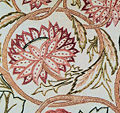
Straight stitch
Encyclopedia


Embroidery
Embroidery is the art or handicraft of decorating fabric or other materials with needle and thread or yarn. Embroidery may also incorporate other materials such as metal strips, pearls, beads, quills, and sequins....
and sewing
Sewing
Sewing is the craft of fastening or attaching objects using stitches made with a needle and thread. Sewing is one of the oldest of the textile arts, arising in the Paleolithic era...
stitches in which individual stitches
Embroidery stitch
In everyday language, a stitch in the context of embroidery or hand-sewing is defined as the movement of the embroidery needle from the backside of the fabric to the front side and back to the back side. The thread stroke on the front side produced by this is also called stitch...
are made without crossing or looping the thread
Yarn
Yarn is a long continuous length of interlocked fibres, suitable for use in the production of textiles, sewing, crocheting, knitting, weaving, embroidery and ropemaking. Thread is a type of yarn intended for sewing by hand or machine. Modern manufactured sewing threads may be finished with wax or...
. These stitches are used to form broken or unbroken lines or starbursts, fill shapes, and create geometric designs.
Running stitch
Running stitch
The running stitch or straight stitch is the basic stitch in hand-sewing and embroidery, on which all other forms of sewing are based. The stitch is worked by passing the needle in and out of the fabric...
, Holbein or double-running stitch
Holbein stitch
Holbein stitch is a simple, reversible line embroidery stitch most commonly used in Blackwork embroidery and Assisi embroidery. The stitch is named after Hans Holbein the Younger , a 16th-century portrait painter best known for his paintings of Henry VIII and his children, almost all of whom are...
, satin stitch
Satin stitch
In sewing and embroidery, a satin stitch or damask stitch is a series of flat stitches that are used to completely cover a section of the background fabric...
and darning stitch are all classed as straight or flat stitches. Backstitch
Backstitch
Backstitch or back stitch and its variants stem stitch, outline stitch and split stitch are a class of embroidery and sewing stitches in which individual stitches are made backward to the general direction of sewing...
is also sometimes included in this category.
Applications
Pattern darning is an ancient technique in which parallel rows of straight stitches in varying lengths are arranged to form geometric patterns. JapanJapan
Japan is an island nation in East Asia. Located in the Pacific Ocean, it lies to the east of the Sea of Japan, China, North Korea, South Korea and Russia, stretching from the Sea of Okhotsk in the north to the East China Sea and Taiwan in the south...
ese Kogin embroidery is a pattern darning style from the island of Honshū
Honshu
is the largest island of Japan. The nation's main island, it is south of Hokkaido across the Tsugaru Strait, north of Shikoku across the Inland Sea, and northeast of Kyushu across the Kanmon Strait...
, often worked in white cotton
Cotton
Cotton is a soft, fluffy staple fiber that grows in a boll, or protective capsule, around the seeds of cotton plants of the genus Gossypium. The fiber is almost pure cellulose. The botanical purpose of cotton fiber is to aid in seed dispersal....
thread
Embroidery thread
Embroidery thread is yarn that is manufactured or hand-spun specifically for embroidery and other forms of needlework.Threads for hand embroidery include:...
on rough, dark blue indigo-dyed
Indigo dye
Indigo dye is an organic compound with a distinctive blue color . Historically, indigo was a natural dye extracted from plants, and this process was important economically because blue dyes were once rare. Nearly all indigo dye produced today — several thousand tons each year — is synthetic...
linen
Linen
Linen is a textile made from the fibers of the flax plant, Linum usitatissimum. Linen is labor-intensive to manufacture, but when it is made into garments, it is valued for its exceptional coolness and freshness in hot weather....
.
External links
- The Crimson Thread of Kinship is a 12-metre-long embroidery predominately using a straight stitch at the National Museum of Australia

